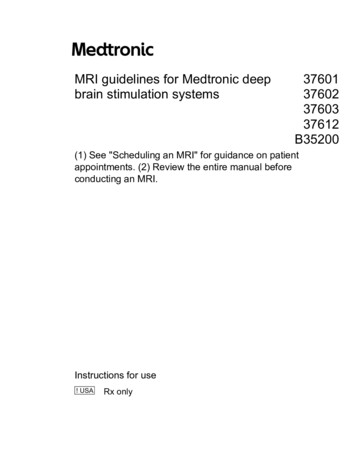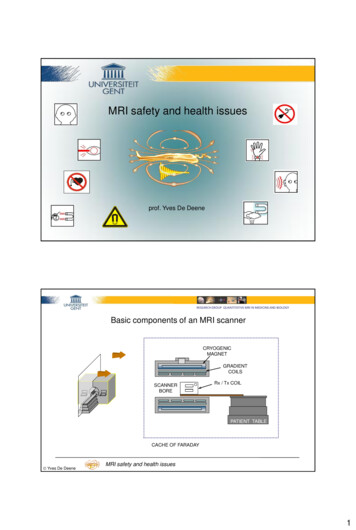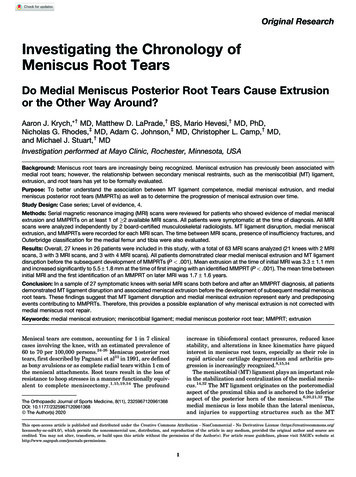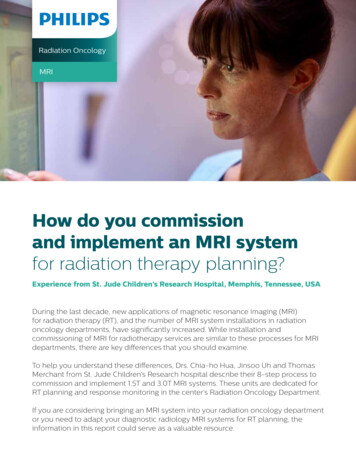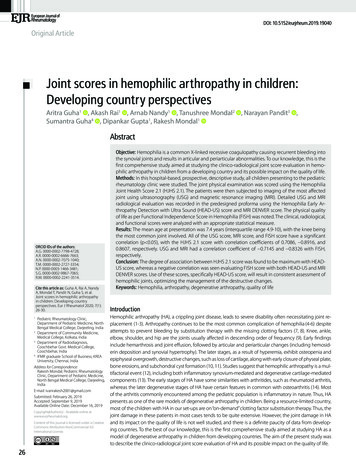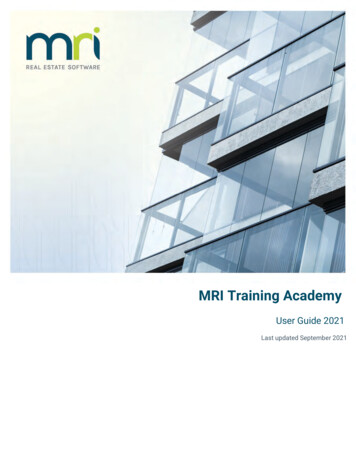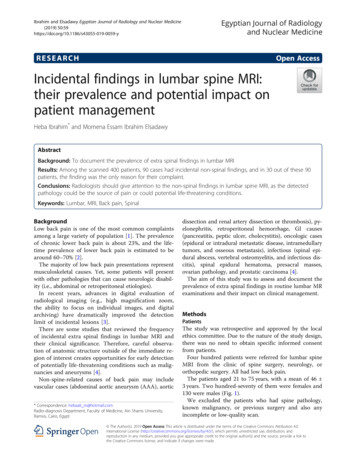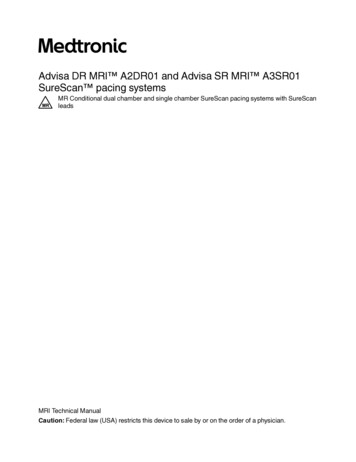
Transcription
Advisa DR MRI A2DR01 and Advisa SR MRI A3SR01SureScan pacing systemsMR Conditional dual chamber and single chamber SureScan pacing systems with SureScanleadsMRI Technical ManualCaution: Federal law (USA) restricts this device to sale by or on the order of a physician.
The following list includes trademarks or registered trademarks of Medtronic in the United States andpossibly in other countries. All other trademarks are the property of their respective owners.Advisa, Advisa DR MRI, Advisa SR MRI, Capture Management, Medtronic, Quick Look, SureScan
Contents1 Introduction 42 MRI conditions for use 42.12.22.32.4Cardiology requirements 4Radiology requirements 4Patient monitoring and rescue requirements 6Training requirements 63 MRI warnings and precautions 64 Potential adverse events 75 Patient monitoring requirements 76 Cardiology-specific considerations 77 Radiology-specific considerations 87.1MRI considerations 88 Pre-MRI scan operations 88.18.2Identification of SureScan pacing system components 8Required patient care 89 Performing an MRI scan 99.19.29.3SureScan pacing system integrity verification 9Programming the MRI SureScan feature to On 9Device considerations 1210 Following the MRI scan 1310.1 Returning the device to the pre-MRI configuration 1311 Medtronic warranty information 1412 Explanation of symbols 1413 Service 143
1 IntroductionThe Medtronic SureScan pacing system is MR Conditional and, as such, is designed to allow patients to be safelyscanned by an MRI machine when used according to the specified MRI conditions for use. When programmed toOn, the MRI SureScan mode allows the patient to be safely scanned while the device continues to provideappropriate pacing. It is important to read this manual before conducting an MRI scan on a patient with animplanted SureScan pacing system. Contact a Medtronic representative if you have further questions.Refer to the appropriate Medtronic clinician manual or lead technical manuals for non-MRI relatedinstructions for use.2 MRI conditions for useA complete SureScan pacing system is required for use in the MR environment. A complete SureScanpacing system includes a Model A2DR01 device with two SureScan leads or a Model A3SR01 devicewith one SureScan lead. To verify that components are part of a SureScan system, visithttp://www.mrisurescan.com. Any other combination may result in a hazard to the patient during an MRI scan.Warning: Do not scan a patient without first programming the MRI SureScan mode to On. Scanning the patientwithout programming the MRI SureScan mode to On may result in patient harm or damage to the SureScan pacingsystem.Note: If a lead impedance measurement value is 200 Ω or 1500 Ω, the software prevents the MRI SureScanfeature from being initiated.Note: The MRI SureScan mode cannot be programmed to On if the device is recommended for replacement.2.1 Cardiology requirementsPatients and their implanted systems must be screened to meet the following requirements: The patient has no implanted lead extenders, lead adaptors, or abandoned leads. The patient has no broken leads or leads with intermittent electrical contact, as confirmed by lead impedancehistory. The SureScan pacing system is implanted in the left or right pectoral region. The pace polarity parameters are set to Bipolar for programming MRI SureScan to On The lead impedance value is 200 ohms (Ω) and 1500 Ω The SureScan device is operating within the projected service life. For patients whose device will be programmed to an asynchronous pacing mode when the MRI SureScanmode is programmed to On, no diaphragmatic stimulation is present when the paced leads have a pacingoutput of 5.0 V and a pulse width of 1.0 ms.Caution: It is not recommended to perform an MRI scan if the right ventricular (RV) lead pacing capture thresholdis greater than 2.0 V at 0.4 ms for pacemaker-dependent patients. A higher pacing capture threshold may indicatean issue with the implanted lead.2.2 Radiology requirementsThe safety and reliability of the SureScan pacing system has been evaluated for scanning patients using MRIequipment that has the following operating characteristics:4
Scanner typeScanner characteristicsHorizontal field, cylindrical bore, clinical system for hydrogen proton imaging Scanner operationStatic magnetic field of one of the following strengths:– 1.5 T– 3TMaximum spatial gradient of 20 T/m (2000 gauss/cm)Gradient systems with maximum gradient slew rate performance per axis of 200 T/m/s1.5T – MRI radio frequency (RF) power – Normal Operating Mode. The whole body averaged specific absorption rate (SAR) must be 2.0 W/kg. The head SAR must be 3.2 W/kg.3T – MRI radio frequency (RF) power – First Level Controlled Operating Mode orNormal Operating Mode: B1 RMS must be 2.8 µT when the isocenter (center of the MRI bore) isinferior to the C7 vertebra. Scans can be performed without restriction when the isocenter is at or superior to the C7 vertebra (see Figure 1).Figure 1. 3T Scan location requirementsNo B1 RMSrestrictionsB1 RMS not toexceed 2.8 μT5
2.3 Patient monitoring and rescue requirementsContinuous patient monitoring is required during the MRI scan.In the event that patient rescue is required, an external defibrillator must be immediately available.2.4 Training requirements A health professional who has completed cardiology SureScan training must be present during theprogramming of the MRI SureScan feature.A health professional who has completed radiology SureScan training must be present during the MRI scan.3 MRI warnings and precautionsWarnings: Do not scan a patient without first programming the MRI SureScan mode to On. Scanning the patient withoutprogramming the MRI SureScan mode to On may result in patient harm or damage to the SureScan pacingsystem. Do not scan patients who do not have a complete SureScan pacing system, which includes a Model A2DR01DR IPG with two SureScan pacing leads, or a Model A3SR01 SR IPG with one SureScan pacing lead. Anyother combination may result in a hazard to the patient during an MRI scan. Do not scan patients with broken, abandoned, or intermittent leads. Lead fractures or other damage to theleads may cause changes in the electrical properties of the SureScan pacing system that will make the systemunsafe for an MRI scan. Patients with damaged leads may be harmed if an MRI scan is performed. Do not scan patients with a SureScan pacing system implanted in sites other than the left and right pectoralregion. Safety and effectiveness have been assessed for left and right pectoral implant locations only.Scanning of patients with devices implanted in other locations could lead to increased pacing capturethreshold or unintended cardiac capture.Cautions: Do not scan patients in a 1.5 T magnetic field with a whole body averaged SAR level 2.0 W/kg. A scan above2.0 W/kg may increase the risk of myocardial tissue damage due to lead tip heating, resulting in an increasein the pacing capture threshold. Do not scan patients in a 3 T magnetic field with a B1 RMS value 2.8 µT when the isocenter (center of the MRIbore) is inferior to the C7 vertebra. A scan above 2.8 µT may increase the risk of myocardial tissue damage dueto lead tip heating, resulting in an increase in the pacing capture threshold. For pacemaker-dependent patients, it is not recommended to perform an MRI scan if the right ventricular (RV)lead pacing capture threshold is greater than 2.0 V at a pulse width of 0.4 ms. A higher pacing capturethreshold may indicate an issue with the implanted lead. Do not scan patients whose device will be programmed to an asynchronous pacing mode when MRI SureScanis on, and who have diaphragmatic stimulation at a pacing output of 5.0 V and at a pulse width of 1.0 ms. It maybe difficult for the patient to remain still in order to obtain a quality MRI scan. Do not scan patients with lead extenders or lead adaptors. Lead extenders and lead adaptors may increasethe risk of MRI-related hazards, including myocardial tissue damage due to lead tip heating. It is not recommended to perform MRI scans during the lead maturation period (approximately 6 weeks)because MRI scans during this period have not been prospectively studied by Medtronic. Scanning patients who have multiple MR Conditional devices present is acceptable as long as the MR labelingconditions for all implants can be satisfied. Do not bring the Medtronic programmer, Patient Assistant, or patient monitor into Zone 4 (MRI magnet room),as defined by the American College of Radiology. They are MR Unsafe.6
4 Potential adverse eventsThe SureScan pacing system is designed to minimize the potential adverse events that may cause patient harm.The following potential adverse events may occur in the MRI environment: lead electrode heating and tissue damage resulting in loss of sensing or capture or both device heating resulting in tissue damage in the implant pocket or patient discomfort or both MR-induced stimulation on leads resulting in continuous capture, VT/VF, hemodynamic collapse, or all three damage to the device or leads causing the system to fail to detect or treat irregular heartbeats or causing thesystem to treat the patient’s condition incorrectly damage to the functionality or mechanical integrity of the device resulting in the inability of the device tocommunicate with the programmer movement or vibration of the device or leads resulting in dislodgment potential for VT/VF induction when the patient is programmed to an asynchronous pacing mode during MRISureScan mode5 Patient monitoring requirementsProper patient monitoring must be provided during the MRI scan and includes both of the following actions: maintaining continuous visual and verbal contact with the patient continuous monitoring of the patient’s heart rate using instrumentation such as pulse oximetry(plethysmography) or electrocardiographyPreparation for patient rescue – In the event that patient rescue is required, an external defibrillator must beimmediately available.Note: If the patient’s hemodynamic function is compromised during the MRI scan, discontinue the scan, removethe patient from the magnet room, and take the proper measures to restore the patient’s hemodynamic function.6 Cardiology-specific considerationsLead maturation – MRI scans during the lead maturation period (approximately 6 weeks) have not beenprospectively studied by Medtronic and are not recommended.Competitive pacing – If an asynchronous MRI SureScan pacing mode is selected, be aware that some patientsmay be susceptible to cardiac arrhythmia induced by competitive pacing. For these patients, it is important to firstselect an MRI SureScan pacing rate that avoids competitive pacing and then minimize the duration of theasynchronous pacing operation. For more information, contact a Medtronic representative.Note: If the patient does not need pacing support, select a nonpacing mode (ODO or OVO).System information and records – All pertinent information about the components of the implanted SureScanpacing system such as model names, model numbers, and serial numbers should be recorded in the patientrecord and on the Patient Information screen on the programmer. This information will help with systemidentification in the future.Patient ID card – Reference materials, such as an ID card, should be provided to all patients with an implantedSureScan pacing system. These reference materials should indicate that the patient has a SureScan pacingdevice and SureScan leads.Note: Be sure to advise the patient to notify medical personnel that they have an IPG before entering the MRenvironment and to present their patient ID card.7
7 Radiology-specific considerations7.1 MRI considerations3 T whole-body transmit coil RF excitations – 3 T MRI systems using two transmit channels (or fewer) mayoperate in the following RF excitations: two transmit channels (known as Multichannel-2 (MC-2)) or CircularlyPolarized (CP). Systems that use more than two transmit channels have not been studied, but such systems couldbe operated in CP or MC-2, if available.Use of transmit/receive and receive-only coils – There are no restrictions on the use of local transmit/receivecoils for MRI scanning of the head or of the extremities, and there are no restrictions on the placement ofreceive-only coils.Image artifact and distortion – SureScan leads have demonstrated minimal MRI scan distortion for areassurrounding the implanted leads when the device is out of the field of view. Significant MRI scan distortion will resultfrom the presence of the device within the field of view. MRI scan artifacts and distortion resulting from thepresence of the device and the leads within the field of view must be considered when selecting the field of viewand MRI scanning parameters. These factors must also be considered when interpreting the MRI scans.Patient sensation during MRI – The device has been evaluated to ensure no risk of tissue damage. However, thepatient may feel sensations of warmth or vibration in the implant site during the MRI scan. Tolerable levels of thesesensations do not indicate that patient safety has been compromised.8 Pre-MRI scan operationsThe steps in the following sections are required before performing an MRI scan.8.1 Identification of SureScan pacing system componentsUse the following methods to verify that a patient has a SureScan pacing system: Patient records or patient ID card (if applicable): Patient records and the patient ID card, if applicable, arethe most reliable record of the medical devices that have been implanted in the patient. These records areavailable to clinicians other than the device clinician and can be accessed without the presence of the patientor the use of a programmer. These records must be complete and accurate if they are to be used to determinewhether the patient has a SureScan pacing system. Patient information on the programmer: The programmer Patient Information feature is intended to beused by the implanting clinician to document the components of the patient’s SureScan system. If theimplanting clinician has entered the needed information completely and accurately, you can use the PatientInformation feature to determine whether the patient has a SureScan pacing system. The patient may haveother implanted devices that are not approved for use in the MRI environment, but not noted in the patientinformation on the programmer.8.2 Required patient careBefore programming the MRI SureScan mode to On, perform the following actions to help ensure patient safety:Evaluate the patient to determine whether or not pacing support is needed while the MRI SureScanmode is programmed to On. – For patients who require pacing support, set the MRI SureScan pacing mode toDOO, AOO, or VOO when programming the MRI SureScan mode to On. For patients who do not require pacingsupport, set the MRI SureScan pacing mode to ODO (OVO for single-chamber devices) when programming theMRI SureScan mode to On. Asynchronous pacing may increase the risk of arrhythmia. For pacemaker-dependentpatients, it is not recommended to perform an MRI scan if the right ventricular (RV) lead pacing capture thresholdis greater than 2.0 V at a pulse width of 0.4 ms.If the patient will require pacing support, ascertain an appropriate pacing rate. – An appropriate pacingrate is one that will help avoid competitive pacing while the MRI SureScan mode is programmed to On.8
9 Performing an MRI scanWarning: Do not scan a patient without first programming the MRI SureScan mode to On. Scanning the patientwithout programming the MRI SureScan mode to On may result in patient harm or damage to the SureScan pacingsystem.Caution: Do not bring the Medtronic programmer, the Patient Assistant, or the patient monitor into Zone 4 (MRImagnet room), as defined by the American College of Radiology. They are MR Unsafe.When programming the MRI SureScan mode to On, you must select parameters that are appropriate for thepatient. Pacing mode and rate (if applicable) are to be programmed per the physician’s discretion. Based onwhether or not the patient needs pacing support, an asynchronous pacing mode (DOO, AOO, or VOO) or sensingonly mode can be programmed. Sensed events will be ignored by the device when the MRI SureScan mode isprogrammed to On, regardless of the programmed mode. The device maintains the selected parameters until theMRI SureScan mode is programmed to Off after the MRI scan has been completed. After the MRI SureScan modeis programmed to Off, the permanent device parameters are restored.9.1 SureScan pacing system integrity verificationThe SureScan pacing system provides automatic verification that no device or lead issues that may compromisepatient safety during an MRI scan are detected. Before allowing the user to initiate the MRI SureScan feature, theSureScan device application software checks for the following 2 situations:Lead impedance is out of range – If a lead impedance measurement value is 200 Ω or 1500 Ω, orunavailable, the software prevents the MRI SureScan feature from being initiated.Insufficient battery longevity – If the device is at Recommended Replacement Time (RRT) or End of Service(EOS), the software prevents the MRI SureScan feature from being initiated.9.2 Programming the MRI SureScan feature to OnUse the following steps to program the MRI SureScan feature to On:1. Select the Params icon from the tool palette.2. Select Additional Features on the Parameters screen.3. Select the MRI SureScan field (see Figure 2 or Figure 3, as applicable to the implanted device). The MRISureScan Checklist window opens.Figure 2. MRI SureScan selection window for the dual chamber device9
Figure 3. MRI SureScan selection window for the single chamber device4. Select the check box in the upper-left corner if all items on the MRI SureScan Checklist are satisfied for thepatient (see Figure 4).Note: Print the MRI SureScan Checklist if desired.Figure 4. MRI SureScan Checklist5. Select [OK]. The MRI SureScan window opens.6. Program MRI SureScan to On. See Figure 5 or Figure 6, as applicable to the implanted device.7. Select an appropriate MRI SureScan pacing mode and MRI SureScan pacing rate. For patients who require pacing support, program the device to an asynchronous pacing mode (DOO,AOO, or VOO for a dual chamber device or VOO for a single chamber device).Note: An MRI SureScan pacing rate must be selected for the asynchronous pacing mode to avoidcompetitive pacing during the operation of MRI SureScan mode.Note: Pace polarity must be set to bipolar to program MRI SureScan mode to On. For patients who do not require pacing support, program the device to the non-pacing mode (ODO for adual chamber device or OVO for a single chamber device).Note: If the patient’s device is programmed to the non-pacing (ODO or OVO) mode, the MRI SureScanpacing rate (Lower Rate) is not available for programming.10
Figure 5. MRI SureScan settings for the dual chamber device11
Figure 6. MRI SureScan settings for the single chamber device8. Select [PROGRAM].Notes: After the device is programmed for an MRI scan, available options are [Print ], [End Session ], and[Emergency]. The MRI SureScan parameter can also be programmed to Off. Selecting the [Emergency] button while in MRI SureScan mode programs the MRI SureScan parameterto Off. The status of MRI SureScan mode and the programmed parameters may be confirmed by printing theMRI SureScan parameter screen.The device is now ready for the MRI scan.9.3 Device considerationsSuspension of diagnostics and counters – When MRI SureScan mode is programmed to On, the followingdevice diagnostics and counters are suspended: Daily Automatic EGM Amplitude Measurements Daily Automatic Lead Impedance Measurements Daily Atrial Lead Position Check in a dual chamber device Short Interval Counter Bradycardia Event CountersSuspension of Magnet Mode – When MRI SureScan mode is programmed to On, the device does not initiateasynchronous, fixed-rate bradycardia pacing in the presence of a magnet.Automatic amplitude and pulse width selection for MRI SureScan pacing modes – When MRI SureScanmode is programmed to On and the pacing mode is DOO, VOO, or AOO, the device may automatically set theamplitude and pulse width values.12
If the permanently programmed A. Amplitude or RV Amplitude is less than 5.0 V, the amplitude is set to 5.0 V. If thepermanently programmed A. Pulse Width or RV Pulse Width is less than 1.00 ms, the pulse width is set to 1.00 ms.No RRT indication – When MRI SureScan mode is programmed to On, if the battery voltage falls below 2.83 V,the normal RRT indication does not occur.1 If the feature is left on indefinitely, the patient will have no indication thatthe device has reached RRT.Considerations specific to dual chamber devices:Suspension of PVC detection – When MRI SureScan mode is programmed to On, the device does not detectPVCs.Suspension of tachyarrhythmia detection – When MRI SureScan mode is programmed to On in a dualchamber device capable of tachyarrhythmia detection, the device does not detect atrial or ventriculartachyarrhythmias.Suspension of tachyarrhythmia therapies – When MRI SureScan mode is programmed to On in a dualchamber device capable of providing tachyarrhythmia therapies, the device does not deliver these therapies.However, bradyarrhythmia pacing therapy is provided when an asynchronous pacing mode is selected for MRISureScan operation.Automatic PAV selection for DOO mode – If the DOO mode is selected when MRI SureScan mode isprogrammed to On, the device automatically sets the PAV to either the permanently programmed PAV interval or110 ms, whichever is less. However, if the permanently programmed PAV is less than 50 ms, the deviceautomatically sets the PAV to 50 ms when MRI SureScan is programmed to On.10 Following the MRI scanProgram the MRI SureScan mode to Off – Program the MRI SureScan mode to Off as soon as the scan iscomplete. If the mode is not programmed to Off, the device will remain in MRI SureScan mode indefinitely.Check the pacing capture threshold – Check the pacing capture threshold after the scan is complete, and besure that the pacing parameters are programmed adequately for the patient based on the threshold. There is a veryslight risk that the MRI will cause lead tip heating, leading to increased pacing capture threshold and loss ofcapture.Note: The Pacing Threshold Test measures capture thresholds in 0.25 V increments. The actual capture thresholdchange associated with a 0.25 V change is between 0.0 V and 0.5 V. For example, actual thresholds of 1.49 V and1.51 V correspond to measured thresholds of 1.5 V and 1.75 V, respectively. In this case, an actual change of0.02 V results in a measured change of 0.25 V. Similarly, actual thresholds of 1.01 V and 2.00 V correspond tomeasured thresholds of 1.25 V and 2.00 V. In this situation, an actual change of 0.99 V results in a measuredchange of 0.75 V.Atrial and RV Capture Management measures capture thresholds in 0.125 V increments.10.1 Returning the device to the pre-MRI configurationAfter the MRI scan is complete, the MRI SureScan mode must be programmed to Off using the Medtronicprogrammer. Programming the MRI SureScan mode to Off restores the device parameter values to the pre-MRISureScan mode configuration.The device maintains the parameters that were set while initiating MRI SureScan operation until the MRI SureScanmode is programmed to Off after the MRI scan.1RRT indication consists of the following indicators: response to application of magnet asynchronous pacingat 65 bpm; upon interrogation, an RRT warning message is displayed to the user.13
Perform the following steps to program the MRI SureScan mode to Off:1. In the MRI SureScan field of the MRI SureScan screen, select [Off].2. Select [PROGRAM].3. Select [Close] to return to the Parameters window.The device parameter values are now restored to the pre-MRI SureScan configuration.Note: During each interrogation, the device is monitored for possible electrical reset conditions and disabledtherapies. If a condition is detected that requires attention, the programmer displays a Device Status Indicatorwarning in a pop-up window and on the Quick Look II screen.11 Medtronic warranty informationPlease see the literature enclosed with the products for information regarding the product warranty or disclaimerof warranty as applicable.12 Explanation of symbolsThe following symbols are related to the magnetic resonance (MR) environment and are used to indicate the safetyof devices and components in the MR environment.SureScan symbolMR Conditional symbol. The Medtronic SureScan pacing system is MR Conditional and,as such, is designed to allow implanted patients the ability to undergo an MRI scan underthe specified MRI conditions for use.13 ServiceMedtronic employs highly trained representatives and engineers located throughout the world to serve you and,upon request, to provide training to qualified hospital personnel in the use of Medtronic products. Medtronic alsomaintains a professional staff to provide technical consultation to product users. For more information, contactyour local Medtronic representative, or call or write Medtronic at the appropriate telephone number or addresslisted on the back cover.14
Medtronic, Inc.710 Medtronic ParkwayMinneapolis, MN 55432USAwww.medtronic.com 1 763 514 4000Medtronic USA, Inc.Toll-free in the USA (24-hour technicalconsultation for physicians and medicalprofessionals)Bradycardia: 1 800 505 4636Tachycardia: 1 800 723 4636 2016 MedtronicM961531A001 B2016-04-29*M961531A001*Europe/Middle East/AfricaMedtronic International Trading SàrlRoute du Molliau 31Case Postale 84CH-1131 TolochenazSwitzerland 41 21 802 7000Technical manualswww.medtronic.com/manuals
Advisa, Advisa DR MRI, Advisa SR MRI, Capture Management, Medtronic, Quick Look, SureScan. Contents 1Introduction 4 2MRI conditions for use 4 2.1 Cardiology requirements 4 2.2 Radiology requirements 4 2.3 Patient monitoring and rescue requirements 6 2.4 Training requirements 6
